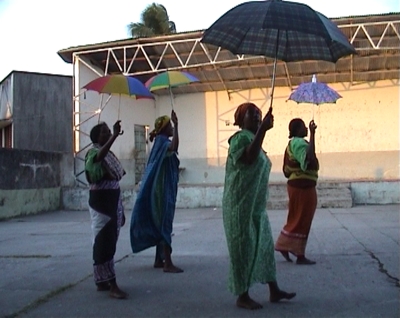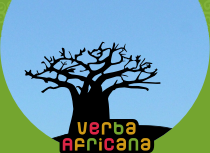Ndege
 Ndege performance
Ndege performance
Ngoma ya Ndege is the last of the ngoma za Unyago which scan the initiation phases: the gesture made by the kungwi, in which the umbrella is taken, danced with and then given to the mwari at the end of the performance, seals the passing of her knowledge to the mwari. This ngoma is the one danced on the day after the first wedding night and it demonstrates that the wedding is arusi nzuri (lit. a fine weeding, more properly what makes a wedding fine is a virgin bride: exposing to the community a tissue with a dash of blood reinforces the introduction of the new couple within the community itself).
- Kamkanyaga msuro
- You brought the answer which moves shame away
- Ndege we
- Oh, you, bird
- Kamkanyaga msuro
- You brought the answer which moves shame away1 2
The dance is a feminine dance although all the drummers are men, and is emblematic of the affirmation of new social roles within the society.
At the beginning of the XXth Century, the subordinate classes began to be integrated into society, as reflected in the emergence of a new ngoma performance, Mkinda: this was a ngoma performance related to the rituals of feminine initiation, in other words, a setting where slave women and women of Arabic descent could meet as could two genres of ngoma: Kunguiya and Ndege.
Bi Kidude remembers these ngoma performances with some nostalgia: they are not still part of the contemporary cultural setting. They are only represented in the schools, on occasion of the mashindano ya skuli, school competitions, where an attempt is made to safeguard the cultural traditions of the islands. She explains the performances in this way:
Mkinda, ukisikia Mkinda ndo unaanzia kufanya habari ya Kunguiya: unavinwa kwanza, Mkinda, unachezewa Mkinda ndani miezi hii mitatu, Mkinda unachezewa wewe ndani. Kuna Mwari-Cheza, kuna Mwari-Kiriri: Mwari-Cheza, unacheza ngoma, Mwari-Kiriri unakaa kitako. Umesikia? Mkinda. Ukeshakuitoka katika Mkinda tena, ndo unachezwa Kunguiya. Ukitoka Kunguiya unakamatishwa mwavuli, si unakamatisha wewe mwenyewe, unakamtishwa na somo yako, unakuwa wewe unarushwa Ndege.3
Mkinda, if you hear talk of Mkinda, it means that you are starting to refer to Kunguiya: firstly you are initiated, with Mkinda, they play and dance Mkinda in your honour while you stay inside (in the house) for three months. They dance Mkinda for you and you are inside. There is Mwari-Cheza and there is Mwari: Mwari-Cheza dances ngoma, Mwari-Kiriri remains sitting. Do you understand me? Mkinda. When Mkinda has finished, they start to dance Kunguiya for you. When Kunguiya has finished, an umbrella is held for you, you can’t hold it by yourself, your somo holds it for you; it means that they start to dance Ndege for you.
In the context of taking part in the dances associated with Mkinda, the slave women had the chance to ‘take possession’ of their Arab owners’ costumes in what was definable as a ‘more respectable’ form of Unyago, an ‘indigenous’ ceremony in which the women belonging to the elite were not allowed to participate.4
In the new social order the annual performance of Mkinda allowed women of different social status to initiate their daughters during a single ceremony which “involved the instructions of Unyago but that
was literally veiled in the symbolism of elite economic and political status.”
5
Mkinda performances also reflected the new multi-ethnic reality of Zanzibar society: “Kunguiya and Ndege were public celebrations that marked the transformation of young girls into women, but they were
simultaneously celebrations of the historical power of women’s sexuality to create bridges between the islands’ diverse ethnic communities.”
6
It was, therefore, a symbol of the common membership to the same community and a public arena where social and ethnic divisions were reconfirmed within the new configuration of society.

